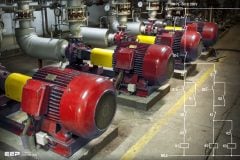Two-state ON-OFF device
The most common motor starting device is the low voltage motor-starting contactor. A contactor is defined as “a two-state ON-OFF device for repeatedly establishing and interrupting an electric power circuit.”

Contactors are designed for optimum performance and lifetime when switching loads; they are not designed for interrupting short-circuit currents and therefore motor circuits require separate short-circuit protection.
For small motors, typically fractional-horsepower, manual control switches are also available. Motor starting contactors and switches in the United States are typically designed and manufactured per NEMA ICS-1, NEMA ICS-2 and UL 508.
A controller is defined as “a device or group of devices that serves to govern, in some pre-determined manner, the electric power delivered to the apparatus to which it is connected.”
Motor starting contactors are available as integral units with externally-operable switching means, defined as a combination controller.
A starter is defined as: “a form of electric motor controller that includes the switching means necessary to start and stop a motor in combination with suitable overload protection”. A combination starter,which includes the motor switching contactor as well as overload protection and an integral disconnecting device, is a type of combination controller.

Low Voltage manual and magnetic controllers are classified as Class A, B, or V according to their interrupting medium and their ability to interrupt currents:
Class A: Class A controllers are AC air-break, vacuum break, or oil-immersed manual or magnetic controllers for service on 600 V or less. They are capable of interrupting operating overloads but not short circuits or faults beyond operating overloads.
Class B: Class B controllers are DC air-break manual or magnetic controllers for service on 600 V or less. They are capable of interrupting operating overloads but not short circuits or faults beyond operating overloads.
Class V: Class V controllers are AC vacuum-break magnetic controllers for service on 1500 V or less, and capable of interrupting operating overloads but not short circuit or faults beyond operating overloads.
Low voltage NEMA-rated contactors are designated in sizes 00 (smallest) through 9 (largest) for various duty applications per [5]. Figure 1 shows a NEMA-rated low voltage contactor along with a manual motor starting switch, a starter, and a combination starter.

Control of contactors using maintained-contact devices is referred to astwo-wire control. Use of momentarycontact devices in the control of contactors is referred to as three-wire control
Two-wire and three-wire control are shown in figure 2 below.

Medium voltage contactors are typically use vacuum as the interrupting means. Unlike a circuit breaker, a medium voltage vacuum contactor is specifically designed for long life in load-interrupting duty rather than for short-circuit interrupting duty.
However, unlike their low voltage counterparts a medium voltage contactor may be able to interrupt short-circuit currents beyond operating overloads.

Medium voltage air-break, vacuum, or oil-immersed controllers are classified as class E. Class E controllers are further divided into class E1 and E2 as follows:
Class E1: Class E1 controllers employ their contacts for both starting and stopping the motor and interrupting short circuits or faults exceeding operating overloads.
Class E2: Class E2 controllers employ their contacts for starting and stopping the motor and employ fuses for short circuits or faults exceeding operating overloads.
Above 7200 V, motor control is generally accomplished using circuit breakers.
Motor starter explained in details (VIDEO)
Copyright Notice
This technical article is protected by U.S. and international copyright laws. Reproduction and distribution of PDF version of this technical article to websites such as Linkedin, Scribd, Facebook and others without written permission of the sponsor is illegal and strictly prohibited.© EEP-Electrical Engineering Portal.
Cant see this video? Click here to watch it on Youtube.
Reference: AC Motors, motor control and motor protection – Bill Brown, P.E., Square D Engineering Services
Copyright Notice
This technical article is protected by U.S. and international copyright laws. Reproduction and distribution of PDF version of this technical article to websites such as Linkedin, Scribd, Facebook and others without written permission of the sponsor is illegal and strictly prohibited.© EEP-Electrical Engineering Portal.
Related electrical guides & articles
Premium Membership
Edvard Csanyi
Hi, I'm an electrical engineer, programmer and founder of EEP - Electrical Engineering Portal. I worked twelve years at Schneider Electric in the position of technical support for low- and medium-voltage projects and the design of busbar trunking systems.I'm highly specialized in the design of LV/MV switchgear and low-voltage, high-power busbar trunking (<6300A) in substations, commercial buildings and industry facilities. I'm also a professional in AutoCAD programming.
Profile: Edvard Csanyi











PLS HELP ME ,HOW TO DOWNLOAD MULTIPLE FILE AT 1 TIME, OR HOW TO DOWNLOAD FOLDER, PLS IMPROVE THIS. I REQUEST U
Good article.
Nice work man.
Dear Edvard,
Could you help me to give a formula to choose the mccb size & determine setpoint over load relay for protection motor 380Vac, 3 phase?
Im very appreciate your feedback and thank you so much.
Regards,
Budi Hermanto